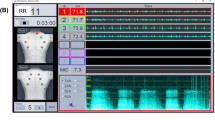Abstract
Although respiratory sounds are useful indicators for evaluating abnormalities of the upper airway and lungs, the accuracy of their evaluation may be limited. The continuous evaluation and visualization of respiratory sounds has so far been impossible. To resolve these problems, we developed a novel continuous visualization system for assessing respiratory sounds. Our novel system was used to evaluate respiratory abnormalities in two patients. The results were not known until later. The first patient was a 23-year-old man with chronic granulomatous disease and persistent anorexia. During his hospital stay, he exhibited a consciousness disorder, bradypnea, and hypercapnia requiring tracheal intubation. After the administration of muscle relaxant, he suddenly developed acute airway stenosis. Because we could not intubate and ventilate, we performed cricothyroidotomy. Subsequent review of our novel system revealed mild stridor before the onset of acute airway stenosis, which had not been recognized clinically. The second patient was a 74-year-old woman who had been intubated several days earlier for tracheal burn injury, and was extubated after alleviation of her laryngeal edema. After extubation, she gradually developed inspiratory stridor. We re-intubated her after diagnosing post-extubation laryngeal edema. Subsequent review of our novel system revealed serially increased stridor after the extubation, at an earlier time than was recognized by healthcare providers. This unique continuous monitoring and visualization system for respiratory sounds could be an objective tool for improving patient safety regarding airway complications.




Similar content being viewed by others
References
GdAM HSN, Pelosi P, Schultz MJ. High versus low positive end-expiratory pressure during general anaesthesia for open abdominal surgery (PROVHILO trial): a multicentre randomised controlled trial. Lancet. 2014;384(9942):495–503. https://doi.org/10.1016/S0140-6736(14)60416-5.
Fernandez MM, González-Castro A, Magret M, Bouza MT, Ibañez M, García C, Balerdi B, Mas A, Arauzo V, Añón JM, Ruiz F, Ferreres J, Tomás R, Alabert M, Tizón AI, Altaba S, Llamas N, Fernandez R. Reconnection to mechanical ventilation for 1 h after a successful spontaneous breathing trial reduces reintubation in critically ill patients: a multicenter randomized controlled trial. Intens Care Med. 2017;43(11):1660–7. https://doi.org/10.1007/s00134-017-4911-0.
Pramono RXA, Bowyer S, Rodriguez-Villegas E. Automatic adventitious respiratory sound analysis: a systematic review. PLoS ONE. 2017;12(5):e0177926. https://doi.org/10.1371/journal.pone.0177926.
Massaroni C, Nicolo A, Lo Presti D, Sacchetti M, Silvestri S, Schena E. Contact-based methods for measuring respiratory rate. Sensors. 2019. https://doi.org/10.3390/s19040908.
Li SH, Lin BS, Tsai CH, Yang CT, Lin BS. Design of wearable breathing sound monitoring system for real-time wheeze detection. Sensors. 2017. https://doi.org/10.3390/s17010171.
Kuo HC, Lo CC, Wang YD, Wu JD, Lin BS. Spectrogram for childhood asthma detection and analysis. Allergy. 2019;74(9):1783–6. https://doi.org/10.1111/all.13768.
Nabi FG, Sundaraj K, Lam CK, Palaniappan R. Characterization and classification of asthmatic wheeze sounds according to severity level using spectral integrated features. Comput Biol Med. 2019;104:52–61. https://doi.org/10.1016/j.compbiomed.2018.10.035.
Enseki M, Nukaga M, Tadaki H, Tabata H, Hirai K, Kato M, Mochizuki H. A breath sound analysis in children with cough variant asthma. Allergol Int. 2019;68(1):33–8. https://doi.org/10.1016/j.alit.2018.05.003.
Nakano H, Furukawa T, Tanigawa T. Tracheal sound analysis using a deep neural network to detect sleep apnea. J Clin Sleep Med. 2019;15(08):1125–33. https://doi.org/10.5664/jcsm.7804.
Jafarian K, Hassani K, Doyle DJ, Lahiji MN, Moghaddam OM, Saket A, Majidi M, Izadi F. Color spectrographic respiratory monitoring from the external ear canal. Clin Sci. 2018;132(24):2599–607. https://doi.org/10.1042/CS20180748.
Göğüş FZ, Karlık B, Harman G. Classification of asthmatic breath sounds by using wavelet transforms and neural networks. Int J Signal Process Syst. 2014. https://doi.org/10.12720/ijsps.3.2.106-111.
Andres E, Gass R, Charloux A, Brandt C, Hentzler A. Respiratory sound analysis in the era of evidence-based medicine and the world of medicine 2.0. J Med Life. 2018;11(2):89–106.
Boriosi JP, Zhao Q, Preston A, Hollman GA, Veyckemans F. The utility of the pretracheal stethoscope in detecting ventilatory abnormalities during propofol sedation in children. Pediatr Anesth. 2019;29(6):604–10. https://doi.org/10.1111/pan.13616.
Jafarian K, Amineslami M, Hassani K, Navidbakhsh M, Lahiji MN, Doyle DJ. A multi-channel acoustics monitor for perioperative respiratory monitoring: preliminary data. J Clin Monit Comput. 2015;30(1):107–18. https://doi.org/10.1007/s10877-015-9693-8.
Acknowledgements
We thank Pioneer Corporation, Nihon Kohden Corporation, and Tokyo Denki University for developing the novel continuous visualization and analysis system for assessing respiratory sounds that was used in this study. We also thank Nancy Schatken, BS, MT(ASCP), and Kelly Zammit, BVSc, from Edanz Group (www.edanzediting.com/ac), for editing a draft of this manuscript.
Funding
This work was supported by the Japan Agency for Medical Research and Development (AMED).
Author information
Authors and Affiliations
Contributions
KK collected the data from the patients and drafted the manuscript. SO contributed to the study conception, analyzed the obtained data, and supervised the drafting of the manuscript. TS contributed to the study conception and constructed the project team. HG, SO, TN and SY collected the data from the patients. NS organized and supervised the entire project. All authors read and approved the final manuscript.
Corresponding author
Ethics declarations
Conflict of interest
The authors have no potential conflict of interest to declare.
Ethical approval
This case report was approved by the institutional ethics committee (Hiroshima University, approval number E-784-4).
Informed consent
Consent for study participation was obtained from the patients or their closest relatives. Written informed consent for publication was obtained from the patients or their closest relatives.
Additional information
Publisher's Note
Springer Nature remains neutral with regard to jurisdictional claims in published maps and institutional affiliations.
Rights and permissions
About this article
Cite this article
Kikutani, K., Ohshimo, S., Sadamori, T. et al. A novel system that continuously visualizes and analyzes respiratory sounds to promptly evaluate upper airway abnormalities: a pilot study. J Clin Monit Comput 36, 221–226 (2022). https://doi.org/10.1007/s10877-020-00641-5
Received:
Accepted:
Published:
Issue Date:
DOI: https://doi.org/10.1007/s10877-020-00641-5




